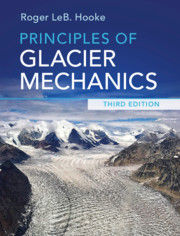Book contents
- Principles of Glacier Mechanics
- Reviews
- Principles of Glacier Mechanics
- Copyright page
- Dedication
- Contents
- Preface to the third edition
- Preface to the second edition
- Preface to the first edition
- Physical constants relevant to ice
- Derived SI units and conversion factors
- 1 Why study glaciers?
- 2 Some basic concepts
- 3 Mass balance
- 4 Flow and fracture of a crystalline material
- 5 The velocity field in a glacier
- 6 Temperature distribution in polar ice sheets
- 7 The coupling between a glacier and its bed
- 8 Water flow in and under glaciers: Geomorphic implications
- 9 Stress and deformation
- 10 Stress and velocity distribution in an idealized glacier
- 11 Numerical modeling
- 12 Applications of stress and deformation principles to classical problems
- 13 Ice streams and ice shelves
- 14 Finite strain and the origin of foliation
- 15 Response of glaciers to climate change
- 16 Ice core studies
- Problems
- References
- Index
16 - Ice core studies
Published online by Cambridge University Press: 20 December 2019
- Principles of Glacier Mechanics
- Reviews
- Principles of Glacier Mechanics
- Copyright page
- Dedication
- Contents
- Preface to the third edition
- Preface to the second edition
- Preface to the first edition
- Physical constants relevant to ice
- Derived SI units and conversion factors
- 1 Why study glaciers?
- 2 Some basic concepts
- 3 Mass balance
- 4 Flow and fracture of a crystalline material
- 5 The velocity field in a glacier
- 6 Temperature distribution in polar ice sheets
- 7 The coupling between a glacier and its bed
- 8 Water flow in and under glaciers: Geomorphic implications
- 9 Stress and deformation
- 10 Stress and velocity distribution in an idealized glacier
- 11 Numerical modeling
- 12 Applications of stress and deformation principles to classical problems
- 13 Ice streams and ice shelves
- 14 Finite strain and the origin of foliation
- 15 Response of glaciers to climate change
- 16 Ice core studies
- Problems
- References
- Index
Summary
Ice cores contain a record of climate change going back close to, and in some cases more than a million years.The record is shorter but more detailed in cores from places with high accumulation rates. The age of ice in cores can be determined by counting sedimentary layers defined by depth hoar or dust, and by analysis of certain chemical species that vary seasonally. The most important of the latter is δ18O. Where records are too low resolution to detect seasonal variations, numerical modeling can be used, although it is less precise. Through study of ice cores we know that concentrations of CO2 in the atmosphere have varied in phase with ice sheet volume over the past 900 ky or so, but it is not clear whether the CO2 led or lagged ice sheet volume.Analysis of a core from the Allen Hills Blue Ice area suggests that the amplitude of oscillations in atmospheric CO2 was smaller prior to 900 ka, when ice sheet volume was varying on a 40 ky time scale. Core records from the Holocene show that atmospheric CO2 and CH4 began to increase when humans began farming; had humans not begun to modify the atmosphere at that time, we would likely be in the middle of an ice age now.
Keywords
- Type
- Chapter
- Information
- Principles of Glacier Mechanics , pp. 433 - 454Publisher: Cambridge University PressPrint publication year: 2019

